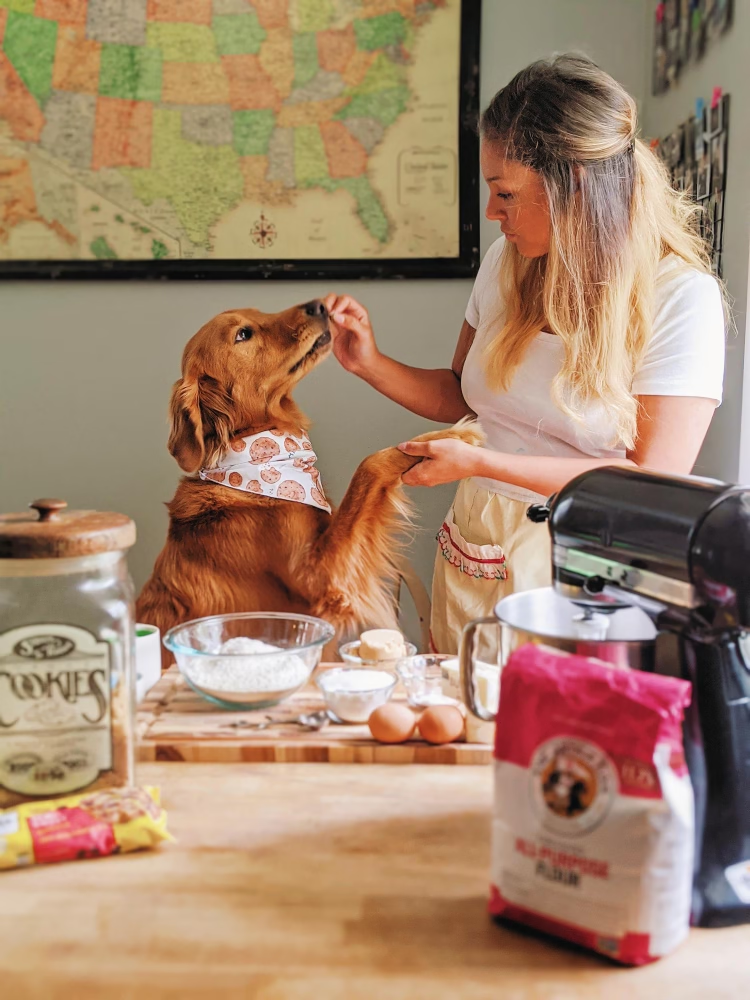
This post may contain affiliate links that at no additional cost to you, we may earn a small commission. Read the Disclosure Policy for more information.
Last Updated on August 27, 2025 by Katie
If you’ve ever thought about baking homemade treats for dogs, you’re not alone. The pet industry keeps growing, and more dog owners want healthy snacks made with real ingredients. That’s why learning how to start a dog treat business is such a smart move for dog lovers looking to earn extra money from home.
By following a step-by-step guide, you can turn your passion for pups into a fun side hustle.
Dog treat businesses often start small, but many owners find it easy to make between $500 and $1,000 a month part-time. As demand rises, you can grow your business at your own pace.
You’ll discover the basics of setting up shop, finding the right recipes, and reaching buyers who care about their dogs’ health.
Making dog treats at home gives you the flexibility to work around your schedule and spend more time with pets, all while building a path to extra income.
If increasing your earnings is a key goal, you might also be interested in these quick ways to make $2,000, for even more ideas.
Want to Make Extra Money Right Now?
- Survey Junkie: Earn money by taking surveys and giving your opinion on new products. Over $1.5 million is paid out to members monthly! Join Survey Junkie now.
- American Consumer Opinion: Get paid for your opinion by taking surveys and participating in research studies. Earn between $1 and $50 per survey. Join ACOP Now.
Is a Dog Treat Business Right for You?

Thinking about turning your kitchen into a home-based dog bakery? Learning how to start a dog treat business is rewarding, but it isn’t for everyone.
You need the right mix of passion, patience, and practical skills to thrive. Before you start whipping up biscuits, get clear about what this side hustle actually involves.
Skills, Passion, and Daily Reality
A successful home dog treat bakery business runs on more than cute branding.
You need a genuine love for pets, plus attention to detail and some comfort in the kitchen. Making consistent, safe, and appealing treats means following recipes precisely, monitoring quality, and sometimes learning basic food science.
If decorating treats sounds fun and not frustrating, you might already have the right mindset.
Your business will also need you to communicate, market, and handle orders—even if you’re an introvert.
Expect to post on social media, connect with dog owners, and coordinate shipping or drop-offs. Enjoying at least some of these tasks is key for long-term motivation.
Time Commitment: A Day in the Life
While starting your business might seem flexible, it does take real time each week.
Baking, packaging, order management, and cleanup all add up fast, especially during busy seasons like holidays or local pet events.
Here’s what a typical workweek might include:
- Baking and prepping batches (2-6 hours)
- Packaging and labelling (1-3 hours)
- Social media and marketing (1-2 hours)
- Handling orders, questions, and deliveries (1-2 hours)
- Record-keeping, supply runs, and administration (up to 1 hour)
Most people fit these tasks around a regular job or family schedule, but you’ll get out what you put in.
Pros and Cons of Running a Dog Treat Business

It helps to think through the ups and downs so you’re not caught off guard.
Pros:
- Make money from home (often $500–$1,000+ monthly from part-time effort)
- Flexibility to set your own schedule
- Creative freedom with recipes and packaging
- Personal satisfaction from happy dogs and owners
Cons:
- Initial setup and regulations take time to learn
- Can be repetitive (lots of baking, packaging, and cleaning)
- Sales vary by season
- Competition with other small makers and commercial brands
For more ways to turn your pet passion into income, check out these side hustles for pet lovers.
Startup Costs: What to Expect
The price to launch a home dog treat business stays low compared to most businesses, but there’s still an investment.
| Expense Type | Estimated Cost (USD) |
|---|---|
| Baking Equipment | $50 – $150 |
| Initial Ingredients | $40 – $100 |
| Packaging Supplies | $30 – $75 |
| Licenses & Permits | $50 – $300 (varies) |
| Branding & Labels | $20 – $100 |
You can start for under $500 in most cases. To see how others balanced costs and growth in the early days, check out real business journeys and tips.
Earning Potential and Profit Margins
Most homemade dog treat businesses sell treats for $5 to $15 per bag.
Your profit margin (what’s left after costs) usually runs between 40% and 70%, depending on your ingredient sourcing, packaging, and whether you sell direct-to-customer or wholesale.
In your first year, clearing $250 to $1,000 a month is realistic if you market consistently and build a loyal local following.
Some side hustlers go much further—but reaching higher profits often means selling in bulk, joining events, or targeting speciality markets.
What You’ll Need to Start
To begin selling dog treats from home, you’ll need a few basics:
- Safe, food-grade baking tools (baking sheets, cutters, bowls)
- Quality ingredients (check with your state for approved items)
- Packaging (bags, tags, labels, sealing supplies)
- Access to recipes proven safe for dogs
- A computer or phone for managing orders and marketing
Some states have label requirements or even special licenses for pet food, so always check with your local department of agriculture before sales begin.
For more insights, visit this forum for pet treat business tips.
Starting a dog treat business fits best for dog lovers who want a blend of creative work, connection with pet owners, and a low-barrier entry to earning money from home.
10 Steps to Start a Dog Treat Business from Home

If you want a step-by-step plan for how to start a dog treat business from your own kitchen, you’re in the right spot.
Below you’ll find each stage broken down, with tips focused on real industry trends for 2025. Follow these simple actions and you’ll go from idea to first sale with confidence.
1. Research the Market and Product Trends
Begin by digging into what today’s dog owners are actually buying.
Check out pet speciality shops and online marketplaces to spot top-selling treats, paying close attention to trending types like grain-free, organic, and functional treats (such as dental chews or calming bites).
Look at ingredient labels, packaging style, and price points for local and online competitors.
Survey friends, local dog owners, or social media groups to see what’s missing in your area.
Maybe pet parents want locally sourced snacks, allergy-friendly options, or treats for sensitive stomachs. Pinpoint your unique selling point. For example:
- Eco-friendly packaging
- Novel ingredients (like exotic proteins)
- Custom treats with pets’ pictures or names
Aim to stand out while solving a real need. According to Pack n Pride’s 2025 insights, personalised nutrition and sustainable packaging are among the fastest-growing trends.
2. Plan Your Business and Set a Budget
Draft a basic business plan. Write out your mission, what makes your treats different, your starting lineup of products, and initial pricing goals.
Estimate how many treats you want to sell weekly and where you’ll sell them.
List your startup costs. Most home dog treat businesses launch with $100 to $500.
Here’s a quick breakdown:
| Expense | Estimated Cost |
|---|---|
| Ingredients (first batch) | $40–$100 |
| Baking tools (if needed) | $20–$80 |
| Mixing bowls, cutters, pans | Already owned or $30 |
| Packaging and labels | $30–$75 |
| Required licenses/permits | $50–$250 (varies) |
Calculate ongoing expenses such as ingredient restocks, packaging, and marketing.
Set a small budget aside for surprises, since supplies often cost more than expected. For a detailed business plan template, visit BizSugar’s startup guide.
3. Register Your Business and Meet Legal Requirements
Starting any pet treat business means checking off all regulatory steps.
Most states require:
- Registering your business name (as an LLC, sole proprietor, or partnership)
- Food business permits (often through your state or local agriculture department)
- Treat registration and a guaranteed analysis (nutritional info on your treats)
The specifics vary, so reach out to your Department of Agriculture or local Small Business office.
You may need insurance, and labelling rules require you to accurately list ingredients and weight.
Some states also require you to register in every state you sell in, with fees from $25 to over $100.
4. Develop and Test Recipes
Focus on recipes that are nutritious, safe, and easy to reproduce.
Choose high-quality ingredients that avoid common allergens; steer clear of sugar, artificial flavors, or chocolate.
Bake several small batches and offer taste tests to dogs you know. Record which flavours go fastest—owners will often have the best feedback.
Document every ingredient with full transparency. Share photos and nutrition info with testers so owners feel safe. Be ready to refine flavours that win the most tail wags.
5. Set Up Your Home Kitchen for Production

You can use most of your standard kitchen gear, but add a few upgrades for efficiency.
Make space for mixing, rolling, and cooling racks. A stand mixer and extra baking sheets help you scale up. Invest in airtight storage bins for both ingredients and finished treats.
Cleanliness is critical. Set clear zones for baking and packing, sanitise all surfaces before and after baking, and store treats safely away from pet hair or household contaminants.
Local regulations often require you to separate pet food from human food prep.
If you want to supply subscription boxes or increase batch size, you can learn about packaging and efficiency in this list of subscription box ideas for pet products.
6. Create Memorable Branding and Labels
When learning how to start a dog treat business, you need to pick a fun, easy-to-remember business name.
Make sure it isn’t already used by searching online and checking domain availability.
Design a simple logo and use a tool like Canva or Fiverr for professional help at a low cost.
Labels are more than decoration. They need to include:
- Ingredient list (by weight)
- Guaranteed analysis (protein, fat, fibre, moisture)
- Your business info (name and address)
- Net weight of treat contents
Follow FDA pet food labelling rules and any extra state guidelines you find while registering. Eye-catching, clear packaging builds instant trust and repeat sales.
7. Price Your Treats for Profit
To find your price, add up all costs: ingredients, packaging, labour (your time counts), and a small per cent for overhead (like marketing).
Compare these to what similar businesses charge—most small-batch treats sell for $6–$15 per bag.
Aim for profit margins of 40 percent to 60 percent. Consider value-based pricing for unique ingredients or custom orders.
Always round up a little to account for rising costs, and review your prices every few months based on real expenses and buyer feedback.
8. Choose Where and How to Sell
There are many options for getting your treats into happy paws:
- Local farmers’ markets and craft fairs
- Online via Etsy, your own website, or social channels
- Consignment in pet shops, doggy daycares, or groomers
Subscription boxes are booming—think about bundling your treats with other pet products each month.
Many first-time sellers use Facebook Marketplace, Instagram shops, or craft fairs to build a local following before growing online.
9. Build an Audience and Market Your Business
Start with a dedicated Instagram or Facebook page.
Share cute treat photos, announce sales, post customer testimonials, and show behind-the-scenes baking sessions. Use hashtags that attract pet owners in your area.
Create simple customer loyalty programs, referral rewards, or giveaways to spark word-of-mouth buzz.
Attend local pet events, join online dog communities, and partner with pet influencers for even more reach.
For more on dog treat marketing, check out strategies in this guide to proven marketing tactics for pet brands.
10. Grow and Adapt Your Business
Stay flexible as trends and customer needs shift. Add new flavours, seasonal treats, or speciality bakes such as birthday cakes or allergen-free options.
If things take off, explore selling wholesale to local retailers or scaling up with bigger e-commerce platforms.
Ask for customer feedback at every stage and keep an eye on treat market updates to keep your treats in demand.
In time, you could move from a part-time side hustle to a thriving business with multiple sales channels and product lines.
Tips for Long-Term Success and Growth

Knowing how to start a dog treat business from home gives you a foundation for a steady income, but staying successful in the long run takes more than good recipes.
To stand out and grow, think beyond your first batch of treats. Consistency, adaptation, and genuine care for your customers and their pets all shape your long-term results.
Below, you’ll find proven tips for keeping your business strong well after launch.
Prioritise Ongoing Compliance
Small pet treat businesses can’t afford to ignore rules and regulations. Check for updates to both state and federal requirements often, since they change as new food safety concerns arise.
Each state may have its own registration process, some with different annual fees or paperwork.
Staying compliant also means keeping detailed batch records and tracking every ingredient you use.
- Register your business in every state where you sell.
- Save copies of licenses, receipts, and product labels.
- Review state agriculture and food codes each year.
Keep Up With Industry Shifts
The pet treat market changes quickly. Today’s trends include functional treats, clean ingredients, and options like CBD or probiotics.
Pet owners want more variety and better health outcomes for their dogs, not just basic snacks.
Watch for reports on flavour trends, ingredient innovations, and customer buying habits.
Consider these key growth areas for 2025 and beyond:
- Premium, wellness-focused and functional treats
- Product lines for specific dog breeds or allergies
- Natural and sustainable packaging
- Freeze-dried or plant-based treats
- Limited-ingredient and “human-grade” options
Stay informed by reading reports such as the Top 3 trends in 2025: Customisation, functionality, and premiumization.
Adjust your product line and marketing based on what pet parents are searching for now.
Actively Listen and Respond to Customer Feedback
Customer feedback fuels growth. Encourage buyers to review your treats, share photos, or message you directly about what made their dogs happiest.
Respond to criticism quickly and show you’re always improving.
Loyal customers will notice your extra care, and new ones will trust businesses that put pets first.
Ways to collect and use feedback:
- Add a thank-you note with a QR code for quick surveys.
- Use social media polls to vote on future flavours.
- Offer discounts for buyers who leave honest reviews.
Keep your processes flexible so you can make changes that reflect what people want.
Small improvements to recipes, packaging, or customer service can set you apart as your business grows.
Maintain a Unique and Memorable Brand

A strong brand keeps your dog treat business top-of-mind. Stay consistent with your name, style, and message across every sales channel.
Choose packaging and a company voice that pet owners remember and trust, especially as you expand to new markets or introduce new products.
Key steps:
- Tell your story and why your treats are different.
- Design visually appealing, easy-to-read labels.
- Share behind-the-scenes baking or pet care tips.
A clear brand identity makes your treats easy to recommend.
Learn From Other Pet Business Models
Observing the strategies other successful pet business owners use can help you avoid common mistakes and find creative new ways to sell.
This could include exploring local retail partnerships, joining pet-related events, or offering subscription-style treat boxes.
- Study how other brands use seasonal launches or influencer partnerships to stay relevant.
- Review how competitors handle customer loyalty or referral programs.
- Consider niche markets, like treats for senior dogs or eco-friendly packaging.
Taking these steps will help your business remain strong and adaptable, making it easier to navigate challenges and keep your customers coming back for more.
Final Thoughts on How to Start a Dog Treat Business
Learning how to start a dog treat business opens the door to meaningful extra income and a schedule that fits your lifestyle.
By working through the ten simple steps, you take control of both your creativity and earning potential.
You can enjoy serving fellow dog lovers, with the flexibility to grow your side hustle on your own terms.
With demand for high-quality, natural pet treats on the rise, you are stepping into a market with real opportunity.
The groundwork you lay today—by following proven methods and keeping quality high—can help you build a business that brings value to your community and joy to local pups.